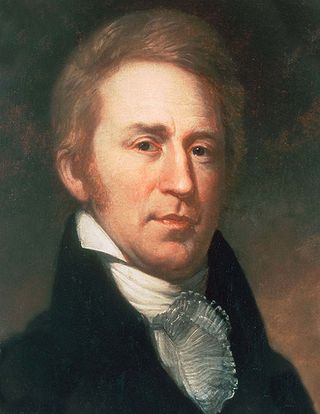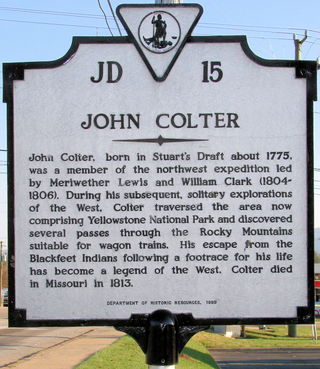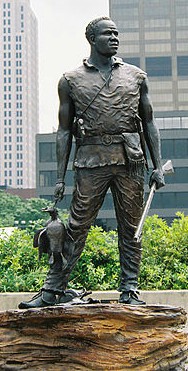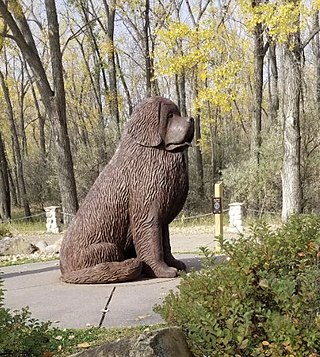Richard Windsor (dates unknown) served the Lewis and Clark Expedition and Corps of Discovery as a hunter, scout, and woodsman.
Windsor was recruited at Kaskaskia in 1803, joining the party as a Private at Camp Dubois, January 1, 1804. Windsor was a great hunter and woodsmen and he was very beneficial to the expedition. He is mentioned in the Lewis and Clark journals for an accident that almost cost him his life. Crossing a bluff when he was with Lewis, he slipped and fell. Lewis ran to the edge and told him to dig his knife in and climb up. He did so, and escaped death. After the expedition, Windsor settled in Missouri but soon rejoined the army and served until 1819. He later lived along the Sangamon River in Illinois.

The Lewis and Clark Expedition, also known as the Corps of Discovery Expedition, was the United States expedition to cross the newly acquired western portion of the country after the Louisiana Purchase. The Corps of Discovery was a select group of U.S. Army and civilian volunteers under the command of Captain Meriwether Lewis and his close friend Second Lieutenant William Clark. Clark and 30 members set out from Camp Dubois, Illinois, on May 14, 1804, met Lewis and ten other members of the group in St. Charles, Missouri, then went up the Missouri River. The expedition crossed the Continental Divide of the Americas near the Lemhi Pass, eventually coming to the Columbia River, and the Pacific Ocean in 1805. The return voyage began on March 23, 1806, at Fort Clatsop, Oregon, and ended on September 23 of the same year.

Meriwether Lewis was an American explorer, soldier, politician, and public administrator, best known for his role as the leader of the Lewis and Clark Expedition, also known as the Corps of Discovery, with William Clark. Their mission was to explore the territory of the Louisiana Purchase, establish trade with, and sovereignty over the natives near the Missouri River, and claim the Pacific Northwest and Oregon Country for the United States before European nations. They also collected scientific data, and information on indigenous nations. President Thomas Jefferson appointed him Governor of Upper Louisiana in 1806. He died of gunshot wounds in what was either a murder or suicide, in 1809.

William Clark was an American explorer, soldier, Indian agent, and territorial governor. A native of Virginia, he grew up in pre-statehood Kentucky before later settling in what became the state of Missouri.

Toussaint Charbonneau was a Canadian-born explorer, fur trapper and merchant who is best known for his role in the Lewis and Clark Expedition as the husband of Sacagawea.

The Corps of Discovery was a specially established unit of the United States Army which formed the nucleus of the Lewis and Clark Expedition that took place between May of 1804 and September of 1806. The Corps was led jointly by Captain Meriwether Lewis and Second Lieutenant William Clark. Commissioned by President Thomas Jefferson, the Corps' objectives were scientific and commercial – to study the area's plants, animal life, and geography, and to learn how the Louisiana Purchase could be exploited economically. Aside from its military composition, the Corps' additional personnel included scouts, boatmen, and civilians.

Jean Baptiste Charbonneau was a Native American-French Canadian explorer, guide, fur trapper, trader, military scout during the Mexican–American War, alcalde (mayor) of Mission San Luis Rey de Francia and a gold digger and hotel operator in Northern California. His mother was Sacagawea, a Shoshone Native who worked as a guide and interpreter for the Lewis and Clark Expedition. Charbonneau spoke French and English and learned German and Spanish during his six years in Europe from 1823 to 1829. He spoke Shoshone and other western Native American languages, which he picked up during his years of trapping and guiding.

John Colter was a member of the Lewis and Clark Expedition (1804–1806). Though party to one of the more famous expeditions in history, Colter is best remembered for explorations he made during the winter of 1807–1808, when he became the first known person of European descent to enter the region which later became Yellowstone National Park and to see the Teton Mountain Range. Colter spent months alone in the wilderness and is widely considered to be the first known mountain man.

Private John Shields (c1769–1809) was, at about 35 years old, the second oldest member of the Lewis and Clark Expedition and its oldest enlisted member. Shields, born in Virginia's Shenandoah Valley, moved at about 14 years old to the wilderness of Tennessee, helped build and lived in a family fort that provided protection from Native Americans, traveled with Captain Meriwether Lewis, Second Lieutenant William Clark, and Native American Sacagawea to the Oregon Coast where he helped build Fort Clatsop, and then returned to St. Louis, Missouri. At the completion of this great adventure Shields hunted and trapped with the famous American pioneer Daniel Boone.
George Drouillard (1773–1810) was a civilian interpreter, scout, hunter, and cartographer, hired for Lewis and Clark's Voyage of Discovery to explore the territory of the Louisiana Purchase in 1804–1806, in search of a water route to the Pacific Ocean. He later worked as a guide and trapper for Manuel Lisa on the upper Missouri River, joining his Missouri Fur Company in 1809. It is believed that Drouillard was killed in what is now the state of Montana while trapping beaver, in an attack by the Blackfeet or Gros Ventre tribes.

York was an American explorer and historic figure, being the only African-American member of the Lewis and Clark Expedition; he participated in the entire exploration and made significant contributions to its success. He was the first African American to cross the continent and see the Pacific. He has become an American icon and several monuments depicting him have been erected honoring his legacy.

Patrick Gass served as sergeant in the Lewis and Clark Expedition (1804–1806). He was important to the expedition because of his service as a carpenter, and he published the first journal of the expedition in 1807, seven years before the first publication based on Lewis and Clark's journals.

Seaman, a Newfoundland dog, was a member of the Lewis and Clark Expedition, the first trip from the Mississippi River to the Pacific coast and back. He was the only animal to complete the entire three-year trip.

A buffalo jump, or sometimes bison jump, is a cliff formation which Indigenous peoples of North America historically used to hunt and kill plains bison in mass quantities. The broader term game jump refers to a man-made jump or cliff used for hunting other game, such as reindeer.
Reubin Field was a woodsman and skilled hunter. With his brother Joseph, he was a member of the Lewis and Clark Expedition, as one of the "nine young men from Kentucky" and one of the first to be recruited in August 1803. Both were mentioned many times in the journals of Lewis and Clark. The Field Brothers were also some of the best hunters on the expedition

Sacagawea was a Lemhi Shoshone woman who, in her teens, helped the Lewis and Clark Expedition in achieving their chartered mission objectives by exploring the Louisiana Territory. Sacagawea traveled with the expedition thousands of miles from North Dakota to the Pacific Ocean, helping to establish cultural contacts with Native American people and contributing to the expedition's knowledge of natural history in different regions.

William Dunbar (1749–1810) was a Scottish-American merchant, plantation owner, naturalist, astronomer and explorer.
The first Fort Lisa (1810-1812), also known as the Fort Manuel Lisa Trading Post, Fort Manuel or Fort Mandan, was started by the notable fur trader Manuel Lisa of the Missouri Fur Company in 1809. This fort was likely where Sacagawea died; she had been the guide for the Lewis and Clark Expedition. Fort Lisa superseded Fort Raymond as the uppermost post of the Missouri Fur Company on the Missouri River. In 1812 Lisa built a replacement fort downriver near present-day North Omaha, Nebraska, which he also named Fort Lisa.
Events from the year 1805 in the United States.
Events from the year 1806 in the United States.
James P. Ronda is a now retired Western American historian. He is also an emeritus professor of history at the University of Tulsa. During his career, which began at Youngstown State University and finished at the University of Tulsa, Ronda became known for his research on the Lewis and Clark Expeditions. He has written multiple works on the subject, as well as appearing on C-Span for a special presentation about the writings of Lewis and Clark, which aired in 2001. Ronda's 1984 book Lewis and Clark: Among the Indians has contributed the most to his reputation as an authority on the subject. Ronda's largest contribution to his field of study was his inclusion of the Native American perspective in the Lewis and Clark expeditions.